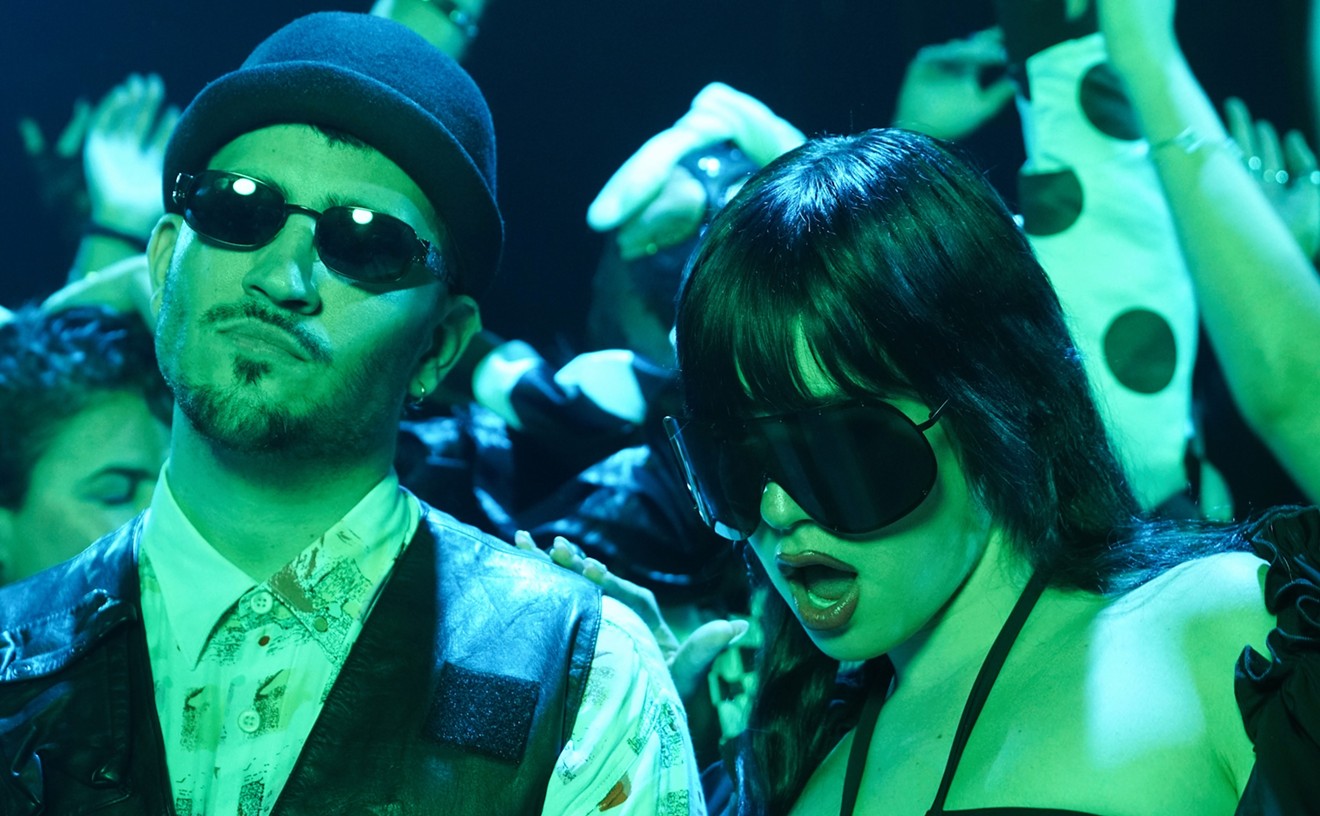Perhaps this was intentional. Perhaps the black monoliths were intended as minimalist sculptures. Or perhaps they were conceptual pieces intended as a comment on the draconian effects of censorship.
Alas, there was a more prosaic and disappointing explanation.
As a friendly security guard volunteered, he and the other guards on duty had simply elected not to turn the tape players on that day. "That tape isn't very interesting anyway," he opined, pointing to an installation by Laura Howe featuring large bright-color Plexiglas cutouts painted with the faces of women rockers such as Patti Smith, Deborah Harry, and Marianne Faithfull. The boom box on the floor should have been playing a recording of the 30-year-old artist amateurishly covering their hits. The idea was to illustrate the singers' influence as role models on the young Howe.
The guard agreed, only grudgingly, to turn the music on. "It all sounds the same," he griped. In this case he happened to be right. Howe's yodeling was pretty monotonous, if purposely so. But that's beside the point. Sound is an integral element of several works in the show, and silencing them is akin to tearing an arm off a Michelangelo sculpture or throwing a sheet over a Picasso nude. Someone at the museum should of course be taking care to make sure that the works are fully operational at all times, (i.e., music should play continuously). If the Lowe is quiet, ask the staff to turn the music on. If all else fails, push the start buttons yourself.
Then skip Howe's forgettable pop-kitsch installation and make your way over to where a marionette in a loud suit and bow tie is doing the white guy shuffle -- head bobbing, arms stiffly swinging, foot tapping over and over on the floor. The motorized puppet is suspended from ceiling wires, and it has the face of its creator, conceptual artist Dennis Oppenheim. The two-foot-tall marionette is one of a series of alter egos the artist made in 1974. Titled Theme for a Major Hit, Oppenheim's manic puppet show evokes the public's typical knee-jerk reaction to catchy Top 40 songs, and further, it illuminates how the presence of popular music in every aspect of daily life has spawned a society of dancing fools. It's also a lot of fun to watch. The artist wrote and recorded the crashing, Stones-esque song to which the puppet grooves. Backed by a band of artist buddies, Oppenheim repeatedly sings, "It isn't what you make, it's what makes you do it."
The music for Oppenheim's piece was also turned off on a recent visit. Most unfortunate, because the lyric sums up what this exhibition is about. "It's Only Rock and Roll" shows the many ways in which visual artists have been influenced by rock and rock stars. But more specifically, curator David S. Rubin has set out to capture the Zeitgeist that rock music shares with contemporary art.
The works of Fifties and Sixties beat and pop artists, for example, embody the rebellious spirit and anti-establishment ideology of the music of the same era. Most famously, Andy Warhol adopted a rock star pose, and, with the Velvet Underground, employed rock as one of his many artistic media. Subsequent generations of art students, notably the members of Talking Heads, have expressed themselves through music and visuals. And the flamboyant, confrontational behavior of Seventies punk rockers mirrors that of performance artists of the same period.
"This exhibition is not about rock and roll memorabilia, or posters, or art by rock and roll stars -- those things belong in the Rock and Roll Hall of Fame," cautions Rubin, who is the curator of contemporary art at the Phoenix Art Museum. "The exhibition looks at how rock and roll culture has affected artists over the past few decades. And because rock and roll encompasses so many different things, the artists' responses to that culture are as varied as the kinds of art being made today."
With more than 100 works, the show offers a dizzying survey of the ways in which artists and musicians have simultaneously -- and sometimes in collaboration -- examined culture's relationship with commerce, engaged in social and political protest, and experimented with technology. The exhibition includes works from the late Fifties to the present and begins with a historical section.
As the power of rock stars as popular heroes intensified, artists naturally began using images of musicians as contemporary icons. The earliest work in the show, a 1956 photographic collage by Ray Johnson, depicts Elvis Presley as Oedipus, crying tears of blood.
British artist Peter Blake's totemic paintings of the Everly Brothers (1959) and the Beach Boys (1963) capture the heartthrobs in fan magazine poses. Now the works seem stilted and a bit silly, but Blake was among the first artists to recognize the impact of such images in the mass media. He ironically and defiantly embraced popular music as a subject for fine art, appropriating magazine pictures the same way that Warhol immortalized Brillo boxes or that Roy Lichtenstein re-created comic strips.
In a 1970 silkscreen seen here, Signs, Robert Rauschenberg included Janis Joplin's photo among those of an astronaut, a peace rally, the slain Kennedys, and Martin Luther King. More recently, artists have viewed musicians' roles as popular heroes more cynically. The artist team Pruitt-Early, for example, pastes Kiss patches on a background of a Miller beer logo in their early Nineties series, Painting for Teenage Boys.
Throughout the rock era, artists have depicted dead singers as contemporary saints and martyrs -- the show includes portraits of the holy (and overexposed) rock trinity Jimi Hendrix, Joplin, and John Lennon, as well as a painting of Kurt Cobain with his face blown off. This last work, by West Coast surfer-turned-artist Sandow Birk, is modeled after a pre-Raphaelite painting depicting the suicide of an eighteenth-century poet. Sandow's explicit portrait is disquieting, as much for the artist's irreverence in creating it as for the subject matter itself.
Rare is the artist's studio that doesn't contain a stereo and a pile of favorite motivational CDs, or at the very least a paint-encrusted radio. Accompanied by music as they work, painters are often moved to translate musical energy into visual art. Piet Mondrian is the most celebrated, but the best-known contemporary example is probably Jean-Michel Basquiat, who is represented here by Horn Players, an expressive canvas paying homage to Dizzy Gillespie and Charlie Parker that includes portraits of the musicians and scrawling text. (Gillespie and Parker aren't rock musicians, but it's still an exciting painting.)
While some artists attempt to represent music through painting, others use musical hardware as materials. The show provides a brief retrospective look at artistic experiments with musical technology. Video art pioneer Nam June Paik is represented by a lightweight work, Dharma Wheel Turns (1990), a whimsical figure of a man constructed from old LPs, a CD, a laserdisc, a cassette, and topped with Walkman headphones.
Two photos document Laurie Anderson's groundbreaking experiments in the Seventies. One shows her playing her "Viophonograph" -- a turntable mounted on a violin, an altered instrument incorporating live music and recording. If Anderson's work seems dated, it is still an interesting exploration into the validity of recorded sound versus live, and it has contemporary relevance in the debate currently raging over sampling.
A younger artist, Alan Rath, humanizes technology with his anthropomorphic electronic sculptures. His Transmitter, from 1990, is constructed of four speaker cones mounted on a tripod. Like sensuous mouths, the speakers pulsate as if they were breathily whispering to passersby.
A veteran of the New York music scene of the late Seventies, when he provided turntable scratches for the band Mon Ton Son, Christian Marclay is known for using records and other recording material as media for his artworks. He cuts up old LPs and assembles the pieces into new platters that emit garbled noise when played. Covered with psychedelic collages, these Recycled Records can also be hung on the wall, as they are in the exhibition. Unfortunately there's no chance to listen to them in the museum. Also on view is Marclay's The Beatles, a pillow the artist crocheted from tape recorded with Beatles' songs. A sublime surrealist object, the pillow evokes music's ability to alter our emotions and fuel our dreams. By translating music into a tangible, touchable thing, Marclay stresses its visceral yet ethereal quality.
In setting out to document the interaction of contemporary art and music, curator Rubin has largely succeeded. There are many provocative, attractive, or simply enjoyable works here. For all of the highlights, though, there are twice as many works that have no resonance at all.
These include derivative paintings (several mimic Basquiat), innocuous campy installations, and stupidly pretentious conceptual art pieces. (The worst offender is Richard Hawkins, who plasters images of Guns N' Roses guitarist Slash over photos of celebrated modernist Cy Twombly's elegant abstract drawings.) The conglomeration of so many mediocre works risks allowing the stronger pieces to be overlooked, a situation aggravated by museum guards who neglect to turn the sound elements on.
"It's Only Rock and Roll" is a worthy endeavor, but it doesn't manage to make quite enough noise.
"It's Only Rock and Roll" is on exhibit through February 8 at the Lowe Art Museum, 1301 Stanford Dr, Coral Gables; 284-3603. Admission is $5.










